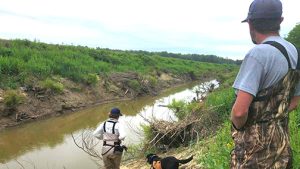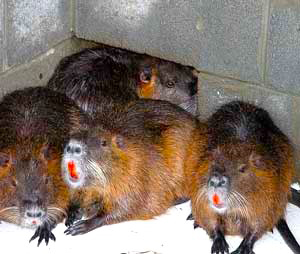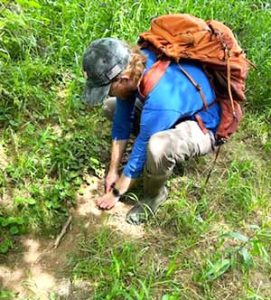by Tim Crosby
CARBONDALE, Ill. – There are four semiaquatic mammals traditionally living in Illinois, but a student researcher at Southern Illinois University Carbondale is using a new technique to keep watch for the presence of a fifth, unwelcome species: nutria, which wreck habitats and spread disease.
Derek Whipkey, a graduate student in zoology, is studying the Southern Illinois distribution of American beaver, muskrat, river otter and American mink, all fur-bearing species that impact the economy. Whipkey also is looking at factors impacting the animals’ distribution and the interactions among them, especially between beaver and otter.

Top: Carl Messick and Lisa Barry of the U.S. Department of Agriculture, work with scenting hound Benny near a Southern Illinois waterway. (Photo provided) Below: Nutria can destroy vital wetland habitat with intense foraging. (Public domain image by U.S. Fish and Wildlife Service) Bottom: SIU graduate student Derek Whipkey looks for signs of aquatic mammals near a waterway in Southern Illinois. (Photo provided)
While he’s at it, Whipkey is also looking into reports of nutria making their way into Southern Illinois. Somewhere between the size of a beaver and a muskrat, nutria reproduce multiple times a year and can destroy vital wetland habitat with intense foraging.
A new, unwanted neighbor
Classified as an aquatic rodent, nutria live in burrows alongside water, feeding on plant stems. The Illinois Department of Natural Resources has received reports of nutria in Southern Illinois, prompting researchers to look into the presence of these invasive creatures, which traditionally live in South America but have been introduced into North America, Europe and Asia primarily by fur farmers.

Although nutria are still hunted and trapped for in some regions, their destructive burrowing and feeding habits often bring them into conflict with humans, and they are considered an invasive species in the United States. Nutria also can transmit diseases to humans and animals, mainly through water contamination.
Looking for clues
Working with his faculty adviser Guillame Bastille-Rousseau, assistant professor at SIU’s Cooperative Wildlife Research Laboratory, and Charlotte Narr, assistant professor of zoology, Whipkey is set up surveillance sites at 67 aquatic areas across Southern Illinois, including Alexander, Pulaski, Massac and Pope counties. At each site, Whipkey looked for visual signs of the mammals’ presence; a technique known as a “sign survey,” as well as deploying motion-activated cameras.
“A sign survey is a traditional method for determining wildlife presence,” Whipkey said. “A typical sign survey consists of an observer walking a transect of some designated length, looking for and recording any physical evidence of the target species. In our case, we had two observers walking a 200-meter transect, looking for sign within 5 meters of the water’s edge.”

Signs can include animal tracks, distinct foraging signs, scat or a number of other indicators unique to a target species.
“My goal is to determine the distribution of semiaquatic mammals as well as finding the most efficient method at detecting these species,” he said. “The sign surveys had the highest detection probability for all native semiaquatic mammal species.”
Using a new tool
In order to specifically confirm the presence of nutria, however, Whipkey also used an old-school method for detecting the mammals – a detection dog – as well as a brand-new, high-tech one known as environmental DNA, or eDNA.
This new, noninvasive method does not directly impact the animals but instead relies on collecting genetic material of target species from the environment, most commonly the local water but also soil and air in more recent applications.
Narr used a pump to filter water and collect samples, which Whipkey used to possibly catch a genetic whiff indicating the presence of nutria.
“The idea is that genetic material in the water will be caught in the filters,” he said. “We then dry the filters and ship them to collaborators who extract the DNA and determined which species were present or had been present within about a week of the survey samples.”
Positive results
The study, funded by the Illinois Department of Natural Resources via the Federal Aid Restoration Act, wraps up in December. So far, eDNA samples have detected nutria at two of the 67 sites Whipkey is surveying. In both cases, the new technique was able to “see” nutria when other survey methods did not.
While the two positive detections of nutria are interesting, Whipkey said they may not be cause for alarm just yet.
“I think it alludes to the idea that nutria are dispersing into Southern Illinois but have yet to be established,” he said. “There is also the question of if nutria are actually capable of colonizing Southern Illinois. The species is fairly sensitive to cold temperatures and therefore their current range is limited to areas with mild winters. Southern Illinois seems to be right at the border of their range, which may support my previous idea of our detections representing dispersing individuals that are not reproducing.”
However, if climate change models are accurate and Illinois becomes warmer, that may change. Whipkey also is in contact with wildlife experts in Maryland, who told him nutria may cope with colder temperatures by losing their tails. Continued monitoring is key.
“eDNA is a promising approach that could be an important tool in the early detection of an invasive species,” Whipkey said. “It could allow wildlife managers to take action before the species becomes established.”
